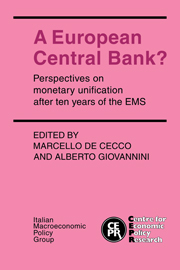Book contents
- Frontmatter
- Contents
- List of figures
- List of tables
- Preface
- List of conference participants
- 1 Does Europe need its own central bank?
- 2 Monetary policy, capital controls and seigniorage in an open economy
- 3 Seigniorage in Europe
- 4 Factor mobility, uncertainty and exchange rate regimes
- 5 Management of a common currency
- 6 The tastes of European central bankers
- 7 The costs and benefits of a European currency
- 8 The monetary unification process in nineteenth-century Germany: relevance and lessons for Europe today
- 9 The establishment of a central bank: Italy in the nineteenth century
- 10 The founding of the Fed and the destabilization of the post-1914 US economy
- 11 Panel discussion on the prospects for a European Central Bank
- Index
5 - Management of a common currency
Published online by Cambridge University Press: 05 February 2012
- Frontmatter
- Contents
- List of figures
- List of tables
- Preface
- List of conference participants
- 1 Does Europe need its own central bank?
- 2 Monetary policy, capital controls and seigniorage in an open economy
- 3 Seigniorage in Europe
- 4 Factor mobility, uncertainty and exchange rate regimes
- 5 Management of a common currency
- 6 The tastes of European central bankers
- 7 The costs and benefits of a European currency
- 8 The monetary unification process in nineteenth-century Germany: relevance and lessons for Europe today
- 9 The establishment of a central bank: Italy in the nineteenth century
- 10 The founding of the Fed and the destabilization of the post-1914 US economy
- 11 Panel discussion on the prospects for a European Central Bank
- Index
Summary
Introduction
The possibility of European monetary integration has been frequently discussed in the past few decades; see for example the volumes edited by Fratianni and Peeters (1979), Johnson and Swoboda (1973), Salin (1984), and Masera and Triffin (1984). Much of the debate derives from the theory of optimum currency areas originally proposed by Mundell (1961) and extended by McKinnon (1963) (see also a useful recent discussion in Wood, 1986). More generally, Fischer (1983) provides an enlightening commentary on the problems involved. While interesting issues have emerged, the literature has remained informal, with few attempts to provide a systematic foundation on which to base arguments for and against common currency.
Our purpose in writing this paper is to present a formal two-country general equilibrium framework in which the question of alternative monetary systems can be addressed, in the spirit of Helpman (1981) and Helpman and Razin (1982). We are especially interested in contrasting three monetary regimes, flexible exchange rates, a common currency issued autonomously by both countries, and a common currency whose management is delegated to a jointly controlled central bank. Flexible exchange rates are the appropriate reference case, since they will prevail whenever either country deviates from the common currency agreement. We keep our model very simple, especially in that we assume complete information and consider only the case of two countries. As an added simplification we summarize each country's welfare in terms of a single representative citizen.
- Type
- Chapter
- Information
- A European Central Bank?Perspectives on Monetary Unification after Ten Years of the EMS, pp. 131 - 161Publisher: Cambridge University PressPrint publication year: 1989
- 3
- Cited by



